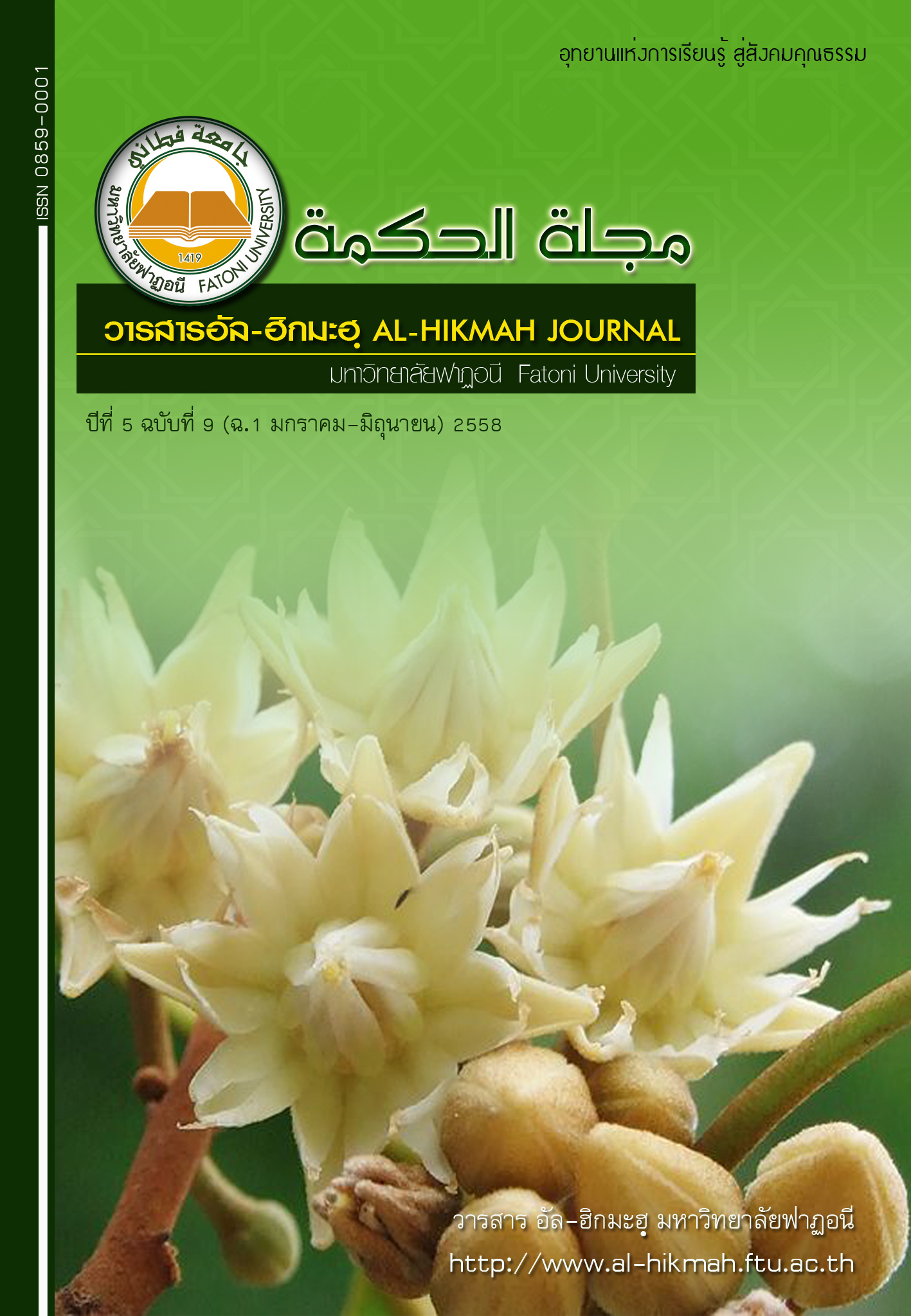Social Roles of Sahabiyat in the Prophet Muhammad Era with Application to Thai Muslim Women in the Society of Three Southern Border Provinces of Thailand
Keywords:
Role, Sahabiyat, Thai Muslim woman.Abstract
This research aims at 1) studying the roles of Sahabiyat in the Madinan Society at the time of the Prophet Muhammad, 2) investigating the level of current Thai Muslim women in the three Southern Border Provinces of Thailand in practicing Sahabiyat’s roles, and 3) synthesizing the suggestions to develop the roles of current Thai Muslim women in the three Southern Border Provinces of Thailand in accordance with the roles of Sahabiyat. Qualitative method which documents, in-depth interview and focus group discussion of 16 experts, and quantitative method which composes of 90 questionnaires were used in collecting data.
The document findings revealed that Sahabiyat at the time of the Prophet Muhammad played an important role in the society and culture, economy, education and politics. The quantitative study showed that the level of Thai Muslim women in three Southern Border Provinces in practicing the 4 aspects of Sahabiyat’s roles is in the average. The results of the synthesis of the experts’ suggestions to develop the role of Thai Muslim women in the three Southern Border Provinces are summarized as follows: 1) campaigning for disseminating knowledge about Sahabiyat in all aspects throughout all levels of the society, 2) creating an understanding and awareness among Muslim leaders at all levels of the need to promote the role of Thai Muslim women in the three Southern Border Provinces in accordance with the roles of Sahabiyat, 3) producing a new generation of Muslim women leaders who are fully equipped with textual and contextual knowledge and understanding, 4) developing Islamic educational concepts to cover objectives and goals of Islamic education, and 5) providing space for Muslim women’s participation in religious organizations. The study also revealed that educational, religious, judicial institutions and Muslim women organizations which are functioning in the three Southern Border Provinces are vital mechanism to drive up and develop the roles of Thai Muslim women in accordance with the role of Sahabiyat.
References
Abu Dawud, Sulayman Ibn al-Ash‘ath al-Sijistani. 1424. Sunan Abi Dawud. 2nd edition. Al-Riyad: Maktab Al-Ma‘arif.
Abu Nu‘aym, Ahmad Ibn ‘Abdullah al-Asfahani. 1998. Ma‘rifat al-Sahabah. Vol.I-VII. Al-Riyad: Dar al-Watan.
Badawi, Jamal A. 1980. The Status of Woman in Islam.
http://www.Institutealislam.com/the-status-of-woman-in-islam-by-dr-jamal-badawi/ (accessed February 25, 2011)
Bin Haji Othman, Haji Faisal. 1993. Woman, Islam and Nation Building. Kuala Lumpur: Berita Publishing.
Al-Bayhaqi. 2003. Al-Sunan al-Kubra. Vol.I-XI. Beirut:Dar al-Kutub al-‘Ilmiyah.
Al-Bukhari. 1400. Al-Jami‘ al-Sahih. Vol.I-IV. Qahirah: Maktabah al-Salafiyah.
Hisam al-Din, Zahir Muhammad ‘Abdullah. 2002. Ta‘lim al-’Inath Fi al-‘Alam al-Islami.
www.isesco.org.ma/ rabe/publications/taaliminath /P5.php accessed December 20, 2011).
Ibn Abi Shaybah. 2006. Al-Musannaf. Vol.X. Beirut: Dar al-Qurtubah.
Ibn al-Athir. 1994. ’Usd al-Ghabah Fi Ma‘rifat al-Sahabah. Vol.VII. Beirut: Dar al-Kutub al-‘Ilmiyah
Ibn Habib, Abu Ja‘far al-Baghdadi. n.d. Kitab al-Muhabbar. Beirut: Dar al-Afaq al-Jadidah.
Ibn Hajar. 1853. Al-Isabah Fi Tamyiz al-Sahabah. Vol.VIII. Beirut: Dar al-Kutub al-‘Ilmiyah.
Ibn Hajar. 2005. Fath al-Bari bi-Sharh Sahih al-Bukhari. Vol.I-XVII. Al-Riyad: Dar Tayyibah.
Ibn Hanbal, Ahmad Ibn Muhammad. 1995. Musnad. Vol.I-V. Beirut: Muassasah al-Risalah.
Ibn Hisham. 1990. Al-Sirah al-Nabawiyah. Vol.I-IV. Beirut: Dar al-Kitab al-‘Arabi.
Ibn Majah. n.d. Sunan Ibn Majah. Al-Riyad: Maktabah al-Ma‘arif Lil-Nashr Wa al-Tawzi‘.
Ibn Qudamah. 1997. Al-Mughni. 3rd edition. Vol.V. Al-Riyad: Dar ‘Alim al-Kutub.
Ibn Qutaybah. 1996. ‘Uyun al-Akhbar. Vol.II. Al-Qahirah: Dar al-Kutub al-Misriyah.
Ibn Sa‘d. 1990. Al-Tabaqat al-Kubra. Vol.I-VIII. Beirut: Dar al-Kutub al-Ilmiyah.
Ibn Sa‘d. 2001. Kitab al-Tabaqat al-Kabir. Vol.II. Al-Qahirah: Maktab al-Khanji.
Muslim. 1991. Sahih Muslim. Vol.IV. Beirut: Dar al-Kutub al-‘Ilmiyah.
Narongraksakhet, Ibrahem. 2005. “Pondoks and Their Roles in Preserving Muslim Identity in Southern Border Provinces of Thailand”, in Knowledge and Conflict Resolution: The Crisis of the Border
Region of Southern Thailand. Utai Dulyakasem, Lertchai Sirichai, editors. p.69-128. Nakhon si thamarat: School of Liberal Arts, Walailak University.
Al-Nasa’i. n.d. Sunan al-Nasa’i. Al-Riyad: Maktabah al-Ma‘arif Lil-Nashr wa al-Tawzi‘.
Al-Nawawi. n.d. Al-Majmu‘ Sharh al-Muhadhdhib Li-lshirazi. Vol.XVIII. Jiddah: Maktabah al-’Irshad.
Al-Tabarani. n.d. Al-Mu‘jam al-Kabir. Vol.I-XXV. Al-Qahirah: Maktabah Ibn Taymiyah.
Al-Tirmidhi. n.d. Sunan al-Tirmidhi. Al-Riyad: Maktabah al-Ma‘arif Lil-Nashr wa Tawzi‘.



